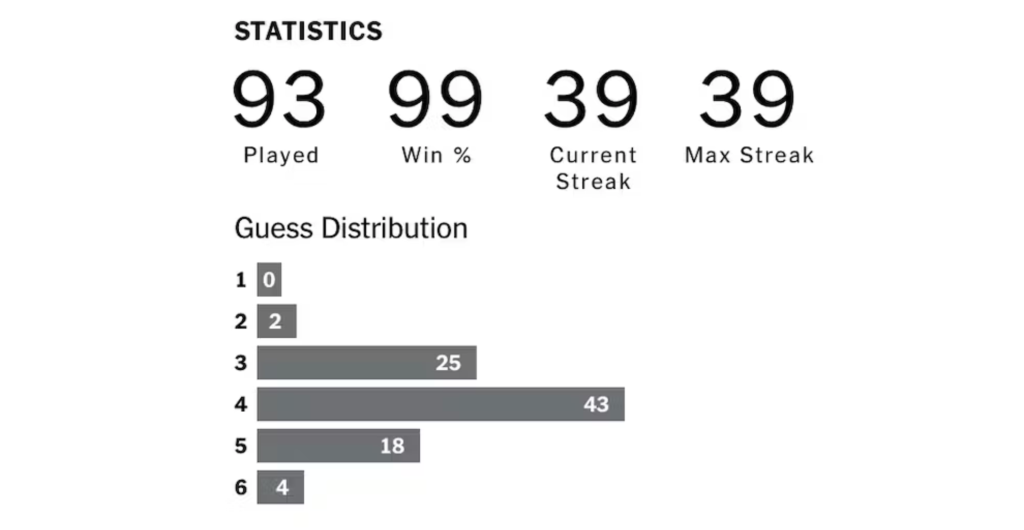
With an unwavering spirit, Dick Coffee never missed attending 781 consecutive University of Alabama football games. Despite illness, storms, and nightfall, Meg Roh maintained a remarkable seven-year daily surfing streak. Jon Sutherland, an epitome of dedication, ran at least 1 mile every day for over 52 years.
The continuity of engaging in a streak of activities possesses the ability to influence behavior, and marketers are keenly aware of its impact.
Marketing researchers, Jackie Silverman and Alixandra Barasch, have recently documented 101 unique instances, which include popular apps such as Snapchat, Candy Crush Saga, Wordle, and the Duolingo language learning platform. These apps have incorporated streaks into their architecture by tracking the number of consecutive days users complete a task. There are even apps dedicated solely to tracking streaks.
What makes streaks so compelling? As someone intrigued by consumer behavior and decision-making, I delved into the phenomenon to gain insights into the motivating influence of streaks. My research, recently published in the Journal of the Academy of Marketing Science, sheds light on this aspect.

What is a streak?
Given the absence of a universally accepted definition for streaks, I initiated the process by attempting to delineate the phenomenon. Drawing insights from individuals sustaining streaks and the portrayal of streaks in popular media, I propose that streaks possess four fundamental characteristics.
Initially, streaks demand consistent adherence to predefined performance and time-related criteria. Simply put, the rules, set by the streak participant or others, outline the parameters for accomplishing the activity and the designated schedule for its completion. For instance, a streak could entail completing a daily session of 50 pushups.
Secondly, the person maintaining the streak predominantly attributes the successful completion of the activity to their determination.
Thirdly, a streak is a consecutive series of the same completed activity that the individual maintaining the streak perceives as uninterrupted.
Fourthly, the individual maintaining the streak quantifies the duration of the series. For example, a streak-holder can precisely state the number of consecutive workdays they’ve biked to the office or provide the exact date the streak commenced.
This definition sets apart an activity streak from winning streaks and lucky streaks. Unlike activity streaks, winning streaks hinge on the performance of others – an opponent – while lucky streaks involve outcomes that are not under the control of the person experiencing the streak.
This definition also emphasizes that streaks are perceptual. Some individuals who have consistently performed an activity may not perceive it as a streak. Others who have not completed the activity every time the opportunity arises may consider it a streak.
Is it a streak, habit, or collection?
Individuals often exhibit behavior patterns, a recurring way of acting in a given situation. While a streak represents a form of patterned behavior, there are other types as well. Many people have habits, which are reflex-like and triggered by the context. For instance, many people automatically fasten their seat belts upon entering a car.
The automatic nature distinguishes a habit from a streak. Unlike a habit, a streak often necessitates the individual to devise a strategy for completing the activity in various situations or contexts. For instance, someone with a streak of running at least 1 mile every calendar day may need to carefully plan a run when traveling across time zones.
While cultivating a habit may be attractive because it minimizes thinking, I found that the challenge of figuring out how to complete the behavior can be a motivating factor for many streak-holders.
Failing to engage in a habitual behavior occasionally will have little impact on the likelihood of the person repeating the behavior in the future. Conversely, failing to perform a behavior that is part of a streak brings an end to the streak.
For some individuals, concluding a streak led to a disheartening view of the behavior in the future: “The streak is over. Why bother?” On the contrary, for others, it strengthened their determination: “The streak is over. I’ve got to start another streak as soon as possible.”
Compiling a set is another form of consistent behavior. Sets typically involve diverse items linked by a shared significance. For instance, Jay Leno is renowned for his assortment of vintage and exotic cars.
However, in contrast to a streak, a set doesn’t conclude if someone neglects to expand it every time the chance arises. I discovered that a collection of experiences or stories is frequently an incidental outcome of sustaining a streak.
Why do streaks motivate behavior?
By leveraging various psychological motivators, streaks can inspire individuals in multiple ways.
Generally, a streak introduces a higher-level goal (sustaining the streak) alongside a lower-level goal (completing an individual activity). Streaks also provide a framework for an activity, and such structure can streamline thinking and decision-making. Your level of importance placed on goal achievement or structure can influence your commitment to a streak.
I also discovered that the structure of a streak can impact the commitment of the streak-holder. For instance, a streak of daily meditation for at least 20 minutes may be more attractive and lead to greater commitment than a streak of meditating for at least 140 minutes each week.
Although the total meditation time is consistent in both scenarios, a daily streak provides structure, streamlining decision-making and motivating the individual to consistently participate in a beneficial behavior.
Streaks can transform the core activity by infusing a gamified element, establishing rules, and quantifying outcomes to create a gaming-like experience. Many individuals find joy in the challenge posed by this gamification, turning routine tasks into an interactive and rewarding game. This structured approach not only adds an element of enjoyment but also provides a clear framework for progress, making it an appealing strategy for those seeking both engagement and accomplishment.
Ultimately, I discovered that activities aligned with one’s identity are more likely to foster a commitment to a streak. For instance, if an individual strongly identifies with religious beliefs, a daily streak of prayer may hold greater appeal than a daily streak of playing Wordle. This is because a streak centered around prayer can serve as a tangible expression of one’s desired identity, providing a means to showcase personal values and beliefs to others.
Although streaks have the power to drive behavior, they may not be universally motivating in all situations. In fact, for some individuals, they might even produce the opposite effect.
Some individuals are deterred by the idea of a streak because they worry about feeling obligated to it, as indicated in the comments of a former streak runner: “I realized that, if I let it, the streak could become a ‘thing’ that controlled my life, my travel, and those around me.”

Streaks and the New Year
With the start of a new year, numerous individuals commit to adopting self-improvement practices aimed at enhancing mental or physical well-being.
Many individuals initiate streaks on January 1 or other significant dates, such as holidays, birthdays, or anniversaries of noteworthy events. These temporal landmarks imbue the streak with meaning and structure, creating a “fresh start effect.”
While many individuals set New Year’s resolutions, only a small percentage successfully achieve them. Based on my research, structuring a resolution as a streak could serve as the nudge that some people need to adhere to not just into the new year but possibly well beyond.
This blog post has been reproduced from The Conversation under a Creative Commons license.





